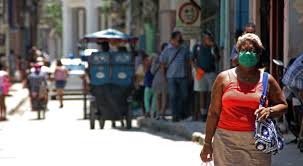CUBA, UN FUTURO INCIERTO, CON UNA ELEVADA DISMINUCIÓN POBLACIONAL, ENVEJECIMIENTO Y UNA BAJA FECUNDIDAD. PHOTOS
CUBA, con un cóctel de disminución y envejecimiento poblacional, mortalidad elevada y baja fecundidad lo hacen uno de los países de un futuro económicamente incierto. Los datos de personas que terminan su periodo reproductivo sin haber tenido hijos muestran valores preocupantes: el 13% en las mujeres y el 24% en los hombres.
Cuba, el país más envejecido de América Latina y el Caribe con el 22,3% de su población con 60 años o más, ha registrado en los últimos cuatro años una disminución poblacional, con niveles de mortalidad elevados y baja fecundidad, dijo el martes Juan Carlos Alfonso Fraga, vicejefe de la estatal Oficina Nacional de Estadísticas e Información (ONEI), al intervenir en el programa oficial radiotelevisado Mesa Redonda.
En palabras de Fraga, Cuba “está experimentando un proceso de transición demográfica temprana y completa, caracterizada por el descenso de la fecundidad y el aumento de la esperanza de vida”, recogió el portal oficial Cubadebate.
“Cuba es un país envejecido, no un país en vías de envejecimiento. Por ejemplo, la Plaza de la Revolución tiene el 30% de su población envejecida, mientras que Villa Clara, La Habana y Sancti Spíritus son las provincias más envejecidas. Las provincias más ‘jóvenes’ se encuentran en el oriente del país”, añadió.
Un reporte del diario oficial Granma, que cita también a la ONEI, señaló que la población de la Isla, al cierre de marzo de 2023, es de 11.082.964. La tendencia al descenso está atada a la baja fecundidad, el balance negativo entre las tasas de natalidad y mortalidad, y el saldo migratorio externo.
Sin embargo, la cifra total de habitantes sería mucho menor, teniendo en cuenta que el régimen no resta a quienes emigran hasta dos años después de su partida e incluso cuenta a los cubanos que han emigrado a otros países, se han regularizado en el exterior, mantienen su residencia en la Isla y realizan viajes frecuentes a la Isla.
Sobre este aspecto, Fraga dijo que “desde 2020 se estima que unos cinco millones de cubanos han realizado movimientos migratorios entre varios países y han regresado” y definió este fenómeno “como la circularidad de la migración”.
CUBA, AN UNCERTAIN FUTURE, WITH A HIGH POPULATION DECLINE, AGING AND LOW FERTILITY. PHOTOS
CUBA, with a cocktail of population decline and aging, high mortality and low fertility make it one of the countries with an economically uncertain future. The data of people who end their reproductive period without having had children show worrying values: 13% in women and 24% in men.
Cuba, the oldest country in Latin America and the Caribbean with 22.3% of its population aged 60 or over, has registered a population decline in the last four years, with high mortality levels and low fertility, said Tuesday Juan Carlos Alfonso Fraga, deputy head of the state National Office of Statistics and Information (ONEI), speaking on the official radio and television program Round Table.
In the words of Fraga, Cuba “is undergoing a process of early and complete demographic transition, characterized by the decline in fertility and the increase in life expectancy,” the official website Cubadebate reported.
“Cuba is an aging country, not a country in the process of aging. For example, the Plaza de la Revolución has 30% of its population aged, while Villa Clara, Havana and Sancti Spíritus are the most aged provinces. The provinces more ‘young’ are in the eastern part of the country,” he added.
A report from the official newspaper Granma, which also quotes ONEI, indicated that the island’s population, at the end of March 2023, is 11,082,964. The downward trend is tied to low fertility, the negative balance between birth and death rates, and the external migratory balance.
However, the total number of inhabitants would be much lower, taking into account that the regime does not subtract those who emigrate until two years after their departure and even counts Cubans who have emigrated to other countries, have been regularized abroad, They maintain their residence on the Island and make frequent trips to the Island.
Regarding this aspect, Fraga said that “since 2020 it is estimated that some five million Cubans have made migratory movements between various countries and have returned” and defined this phenomenon “as the circularity of migration.”
Agencies/ Wiki/ 14yMedio/ Extractos/ Excerpts/ Internet Photos/ Arnoldo Varona/ www.TheCubanHistory.com
THE CUBAN HISTORY, HOLLYWOOD.



 CUBA, an Uncertain Future, with a High Population Decline, Aging and Low Fertility. * CUBA, un Futuro incierto, con una elevada disminución poblacional, envejecimiento y una baja Fecundidad. PHOTOS.
CUBA, an Uncertain Future, with a High Population Decline, Aging and Low Fertility. * CUBA, un Futuro incierto, con una elevada disminución poblacional, envejecimiento y una baja Fecundidad. PHOTOS.





